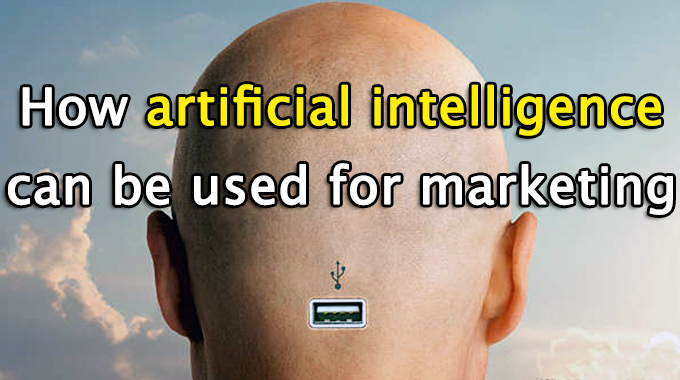How artificial intelligence can be used for marketing

This week sees the launch of our Marketer’s Guide to Artificial Intelligence report, which takes a look at how AI can be used for marketing, now and in the future.
In this extract, report author Martin Talks looks at the various ways marketers can make use of the technology.
1. New customer experiences
Although AI still has limitations, forward-thinking brands are starting to harness its power to enhance the customer experience.
They can do this by creating their own virtual assistants to help customers navigate through their product range or get acquainted with new functionality.
Brands could also tap in to the virtual assistants being created by the Big Five Western tech companies…
Facebook launched a concierge service called M through its Messenger app in 2015.
M can purchase items, get gifts delivered, book restaurants, and make travel arrangements for the user. There is an element of the Mechanical Turk about it at the moment as it is powered by a combination of AI and real-life people.
Apple
Siri has been around for a few years but has been upgraded in that time. It’s now capable of showing
the user specific photos he or she has taken, ordering things via ecommerce apps and giving directions.
It has also been integrated with HomeKit so it can be used to control heating and lighting. It is available on Apple devices only.
Google’s personal assistant Google Now takes a data-hungry approach to providing its service and improves as more data is shared with it.
It anticipates our needs based on our browsing behaviour and consumption of content on social networks. Google Now can be used across Android and Apple devices.
Microsoft
Cortana’s features can set reminders, recognise the user’s voice without them having to first
input a predefined series of commands, and answer questions using information from Bing.
It’s interestingly named – in the Halo game series Cortana is an artificial intelligence that goes wrong…
Amazon
Echo is a connected device that combines the abilities of Siri and a Bluetooth speaker in a 9.25- inch tall cylinder. The built-in personal assistant is called Alexa. Alexa can answer questions, play music from an Amazon library or via Prime, read an audio book, tell the sports results and control the lights.
Baidu
And one must not underestimate China’s Google equivalent, Baidu, which has launched its intelligent virtual assistant Duer.
Duer is built into the Baidu Android search app which is installed on millions of smartphones across China. It is service-oriented, so can order food and access other services through the app.
There are plenty of other plays going on too. In the enterprise space, one of the more interesting is Amelia, while the original inventors of Siri are creating a new virtual assistant called Viv8. Viv grandly describes itself as the “global brain”.
You could reasonably predict that in the not-too-distant future everyone will have a personal concierge in their life not only making recommendations on products and services, but ordering them, paying for them and providing feedback all without our conscious involvement. This of course all has implications for the role of marketing itself as we’ll explore later.
An extension of the virtual assistant role could be assessing performance of products and recommending timing and nature of replacements.
With sensors embedded in products as part of IoT, AI will be able to take a range of readings on products and, for instance, decide if a replacement is desirable or due. A virtual assistant could then make choices based on the performance data.
2. New product launches
There are a whole range of industries launching new products with AI embedded in them, from the smart fridges of LG and Samsung to robo-investing products of the advisory markets. But from a marketer’s point of view, AI can help in the process of any new product launch.
However much preparation a brand makes for a new product launch and however much material is prepared and explanations provided, there are always going to be prospective customers who want to ask questions.
This is not necessarily customer laziness, but a human desire to get reassurance from a fellow being. Through AI that ‘being’ need not necessarily be human.
For instance, BMW employed its iGenius technology in an ad campaign for its first electric car9, which was used to answer customers’ questions about the new model via text.
iGenius increased BMW’s capacity to handle simultaneous questions and reduced the need for BMW to invest in training dealers or customer service staff to handle queries.
One of the more interesting aspects was the technology’s ability to memorise previous questions and so provide more meaningful answers. However, a lot of input is still required to create personable responses with a high standard of knowledge.
3. Insight from data
With vast quantities of data being generated from all areas of business, there has never been a better time to generate insight to improve performance. Although the sheer complexity of this data is beyond human capability, this is very much suited to technology such as AI.
The usefulness of AI for data crunching was dramatically demonstrated in the Google Street View project.
People had been employed to spend weeks tagging buildings and streets in the captured footage. But through the use of Google Brain’s AI capabilities, it was possible to transcribe all of the addresses that Street View has captured in France in less than an hour. It is no wonder that Google has been described as no longer a search company, but as a machine learning company.
Ellipse is a machine learning platform developed by Thoughtly that is designed to accelerate the pace of learning for researchers and students.
Describing itself as AI for research, it provides students and researchers with the ability to analyse, visualise and summarise large volumes of text in real time.12 Individuals can use Ellipse to quickly navigate thousands of resources at once.
Another interesting approach is that of Narrative Science’s Quill. Quill analyses and then adds value to data by identifying the most relevant information and relaying it through professional, conversational language.
Quill aims to provide intelligent narratives that efficiently communicate the insights buried in big data that people can comprehend, act on and trust. Possible uses include producing readable website activity reports based on Google Analytics.
4. Pre-emptive marketing
With sufficient data it is possible to identify patterns of behaviour. To deliver this, the right volume and variety of data need to be gathered and processed in such a way that its veracity, or its level of reliability, can be understood.
By maintaining velocity, or speedy analysis of this data, we can start to establish these patterns with increasing timeliness. This is true big data and beyond human capability. It is an ideal job for AI.
5. Programmatic advertising
Programmatic advertising is already big business. It is the automation of planning, buying and optimising media so advertisers can target specific audiences and demographics. It can be used for online display advertising, mobile and social media campaigns.
The approach can even be used for TV and print. More than half the online display ads being bought in the US are bought programmatically. Google Ad Exchange and Facebook are the main programmatic display sellers.
The benefits of programmatic advertising include its efficiency and simplicity (no negotiation required), and the combination of automation and data which allows better targeting and more informed ad buying.
However, there are issues with programmatic advertising, which include susceptibility to fraud, multiple hidden agency charges and of course the irritation that persistent advertising can cause.
Indeed, the widespread use of ad blocking software is now posing a threat to some forms of online advertising. PageFair predicted that in 2015 as much as $21.8bn (£15.3bn) would be lost in online ad revenue due to ad blockers – and this is expected to increase to $41.4bn (£29bn) in 2016.
AI and the use of virtual assistants could come to the rescue here and change the dynamic of this programmatic advertising. It could be the virtual assistant that decides when it is open to receiving advertising messages and of what type.
This will filter out many of the annoying experiences we currently have of intrusive ads following us around our browsing.
6. Content production
As the previous sections showed, AI can be used in the process of automatically generating and optimising ads. So it should be no surprise that AI is capable of generating the content to populate ads as well as other platforms for sharing content.
This is particularly the case with content that is rooted in data and analytical information. Business information, for example, is likely to be authored by automated writing tools, from press releases and news content through to annual reports. Gartner predicts that by 2018, 20% of business content will be authored by machines.
Indeed, this is already happening as Associated Press (AP) is using an automated system to produce many of its financial stories. If you’re wondering whether an article is written by AI, look out for clues such as these at the end of the article: “This story was generated by Automated Insights.” Here’s an example.
This system produces millions of articles a week for the likes of AP, Samsung, Comcast and Yahoo, and is capable of producing 2,000 articles per second.
Automated Insights also offers specific services aimed at the marketing industry: it can automatically generate campaign summaries, ad performance overviews and brand management reports.
But the content needn’t be dry reporting. TROBO is a lovable, huggable plush toy companion that can help children aged two to five learn about science, technology, engineering and maths through fun, personalised stories.
The TROBOs – Newton and Curie – read the story out loud and the child gets to be the star of the show as their name and avatar feature.
7. Designing websites
Website design is increasingly becoming a commodity, with many free and low-cost platforms to create websites on offer.
But there is no guarantee of quality with these websites and it is not always easy to modify the layout or elements on the site to increase conversion rates.
The Grid offers AI websites that design themselves by algorithmically generating website designs and improving them based on user behaviour.
___
by Graham Charlton

